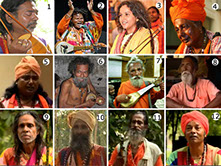



108 Names of Bharat Mata Video
108 Names of Bharat Mata
Gayatri Mantras Video
Bharat Mata Gayatri Mantras
Ekavimski Video
Bharat Mata Ekavimsati Song

Click on Link below to go to Youtube Videos
To download MP3 Audio right click and "save link as"
Home
About the Author
108 Names of Bharatamata
Gayatri Mantras
Ekavimsati Song
Speaking/Media Contact
Sri Bharatamata
Ashtottaram 24
24) OṀ SANNYĀSATVA BHŨMYAINAMAH:
OṀ (AUM) - SON- YAA - SAT - VA - BHOO- MYAI- NA--MA- HA
(Sannyāsam: means 'Renunciation', 'Dispassion')
There is a natural misunderstanding among Hindus, that sannyāsam means leaving everything and sit in a cave with eyes and nose closed. But the actual meaning is dispassion towards materials and relationships which become bondage and the cause for saṃsāra. It is okay to possess materials but one should not be possessed by them. Of the four stages of life, technically called the 'āsramas' (brahmacharyam, gruhastham, vānaprastham and sannyāsam), it is the fourth stage of life. In sādhana chatushṭayam (four fold of spiritual discipline) also, sannyāsam is the second one. It's natural for the wise with enlightenment to feel dispassion about material world and it comes with Self-knowledge which leads to liberation.
There are four types of sannyāsam: 1) Vairāgyam (dispassion) 2) Jnāna sannyāsam 3) Jnāna vairāgyam and 4) Karma sannyāsam. In vairāgyam, again there are three types: Kartrutva tyāgam, sanga tyāgam and phala tyāgam. In sannyasis, there are six different ones: 1) Kutīchaka 2) Bahudaka 3) Hamsa 4) Paramahamsa 5) Turīyata and 6) Avadhūta.
During Kurukshetra war, warrior Arjuna showed vairāgyam to kill his family members, relatives, friends and teachers and Lord Sri Krishna taught him the Karma sannyāsam which was Bhagavadgīta. For Arjuna's doubt whether doing one's karma is greater or sannyāsatvam is greater? Sri Krishna answered to him that 'one should perform according to his mental maturity, own duty and circumstances; and that one path doesn't fit all.' Many pundits wrote commentaries on Bhagavadgīta in thousands of different ways based on their own understanding and sometimes based on political, social and other agendas just as in the case of Max Muller, an European Indologist who was paid heavily by the British government, whose writings intentionally smeared and construed our sacred scriptures with an agenda to ruin and demean our culture.
Sannyāsatvam teaches that the external world we see which has form, and name are bound to be destroyed in time and nothing is eternal except our Self (Soul) which happened to be 'Parabrahman' and the one who recognizes that reality can take sannyāsatvam no matter of what stage of life, he is in. The ochre ward robe the sannyāsis wear is merely symbolic and it represents and reminds constantly the dispassion for that person who took that oath. Because, body is the temple and it is the only vehicle we have to accomplish that goal of liberation, the sannyāsis take food only enough to sustain their bodies. We see these sādhus wearing orange clothes in every village, town and city throughout India; especially places like Hruṣhikesh, Kāsi, and Haridwār. People offer food to them with utmost respect knowing that these sannyāsis have renunciated their families and every material thing inorder to pursue their goal of liberation through vairāgyam.
Our mother land which practices dispassion and renunciation is none other than 'Sannyāsatva Bhūmi.'

